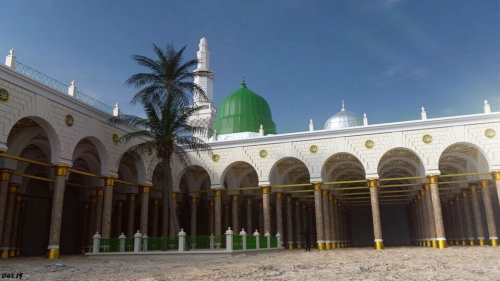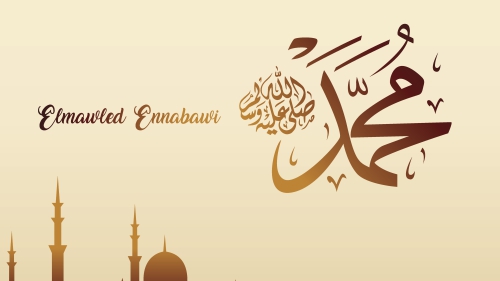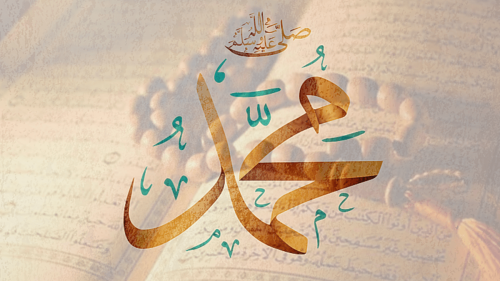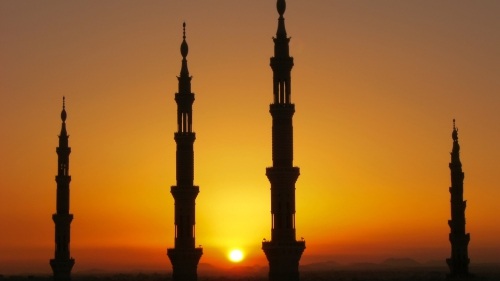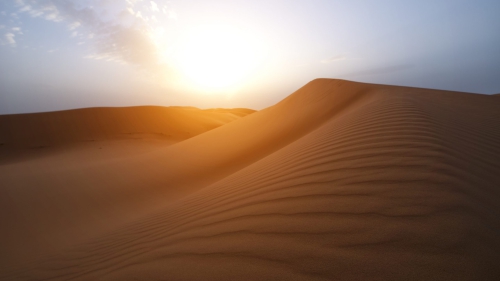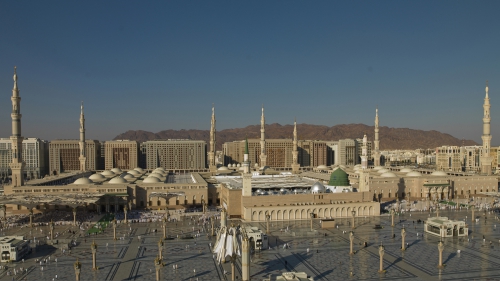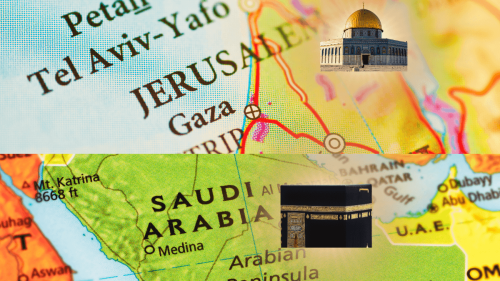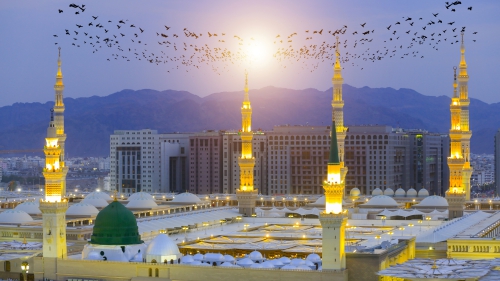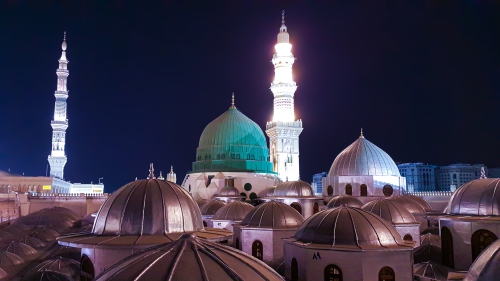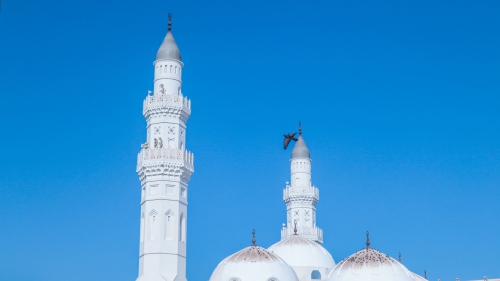The Form of the Prophet's Mosque

When completed, the form of the Prophet's mosque in Madinah was extremely simple. It consisted of an unpaved enclosure with walls made of mud bricks and an arcade on the qiblah side (towards Makkah) made of palm-trunks used as columns to support a roof of palm-leaves and mud. There were initially three entrances which pierced the eastern, western and southern walls. The northern wall was the qiblah side facing al-Masjid al-Aqsa - which was the first qiblah for about one year and a few months. However, as the qiblah was changed to face south towards Makkah, the southern entrance was subsequently bricked up and a wall on the northern side was pierced. Before the qiblah change, there was, in all likelihood, no roofed area in the mosque (some still believe there was) but after the qiblah change, an arcade on the southern side facing Makkah was created. There was no decoration of any kind within or without the mosque.
It must be mentioned, however, that the notion of the mosque (masjid) was not instituted, nor were the mosques built, until the envisaged roles and position of the mosque institution in the forthcoming broad-spectrum development of the Muslim community were implanted into the hearts and minds of its custodians and users. The whole of the Prophet's mission in Makkah, prior to the migration to Madinah where the first self-governing Muslim community was established, is to be seen in this light. That is to say, the Makkah period is to be seen as the laying of a foundation, as well as the setting up of a conceptual framework, for the Madinah period when the first physical manifestations of Islamic culture and civilisation came to pass. Hence, Allah describes the Quba' mosque (the mosque which the Prophet (pbuh) had built in a suburb of Madinah on the way from Makkah) and its patrons in the following words: "... There is a mosque whose foundation was laid from the first day on piety; it is more worthy of thy standing forth (for prayer) therein. In it are men who love to be purified; and Allah loveth those who make themselves pure" (Al-Tawbah, 108).
Notwithstanding its unpretentious and rudimentary structure, the Prophet's mosque from the very first day served as a real community centre quickly evolving into a multifunctional complex. It was meant not only for performing prayers at formally appointed times, but also for many other religious, social, political and administrative functions. The main roles performed by the mosque were as a centre for congregational worship practices, a learning centre, the seat of the Prophet's government, a welfare and charity centre, a detention and rehabilitation centre, a place for medical treatment and nursing, and a place for some leisure activities.
The Prophet's mosque was the nerve-centre of the wide spectrum of the activities and aspirations of the fast-emerging Muslim Ummah. The impact of the mosque complex on the development of Madinah was such that the core of the city eventually grew to be almost ring-shaped, centring around the complex. Thus, the standard was set for every future Muslim city in terms of the role of its principal mosque(s), as well as its position vis--vis the rest of the city's spatial components. So eventful and bustling with life was the Prophet's Mosque that after several years of existence it started to show signs that it could no longer comfortably accommodate the ever-growing number of worshippers, especially on Fridays. It therefore had to be enlarged, which the Prophet (pbuh) did following the conquest of Khaybar in the 7th year after the Hijrah.
At the outset, the Prophet's mosque was very simple because its initial roles were simple, and the mosque's roles were simple because the Muslim community in Madinah was in its infancy. In architecture, the three elements - people's needs, function and form - are inseparable, and in the same order they call for each other. They constitute an architectural "existential trinity". However, as the people's engagements and requirements increased, the functions of the mosque in turn multiplied, calling for some noteworthy improvements in the mosque's original austere form. Thus, during the Prophet's time, his mosque evolved from a simple roofless and plain enclosure to a complex institution that featured, among other aspects, a roofed section, a pavement outside one of its entrances, a minbar (pulpit) and a dakkah or dukkān (seat, bench) for communication purposes, lamps as a means for lighting up the mosque, several compartments that facilitated the various social functions of the mosque, and a person or persons whose job was to keep the mosque clean.
As the Prophet's mosque was the centre of gravity in the wide-ranging affairs of the ever expanding Muslim community in Madinah, its strength and stature epitomised the strength and stature of Islam and the Muslims. The mosque seemed to be accommodative of every beneficial activity concerning worship ('ibadah), education, politics, security and social relations, which enabled the nascent and ambitious society to make some civilizational headway. The Prophet's mosque was the microcosm of the Muslim society in Madinah and its struggle. Thus, it would be appropriate to say that talking about the Prophet's mosque during the time of the Prophet (pbuh) is to talk about the people who instituted and then made the most of it. In the same vein, to talk about the stages which the mosque institution went through during the Madinah period of the Prophet's mission is to talk about the stages which the Muslim community, and with it the Muslim mentality and spirituality, went through.
 |
| An imaginary initial simple form of Prophet Muhammad's mosque after the qiblah change from al-Masjid al-Aqsa to al-Masjid al-Haram; from: Oleg Grabar. 2000. Art and Culture in the Islamic World. In Islam, Art and Architecture, ed. Markus Hattstein & Peter Delius. Cologne: Konemann. p. 41. |
While exemplifying the strength and eminence of Islam and Muslims, the evolution of the Prophet's mosque also exemplified in no less remarkable terms the Prophet's contributions to the evolution of the identity of Islamic architecture. In fact, the origins of all major principles of Islamic architecture can be traced back to the Prophet (pbuh) and his experiences while advancing the position of his mosque in Madinah from a simple unroofed enclosure to a multifunctional community development centre. Such principles, which are generally the principles of Islamic architecture, can be summarized as function-form relationship, peaceful coexistence with the environment (sustainable development), hygiene, comprehensive excellence, just social interactions, "la darar wa la dirar" (there is neither inflicting nor returning of harm), aesthetics, economy, the relationship between the indigenous and foreign influences, respect for people's rights, avoidance of vices and nurturing and promoting virtues.
Introducing the simple original model of the Prophet's mosque was, as a matter of fact, the most appropriate and most viable thing under the circumstances. This was so in view of the general condition of the Muslims and the young Islamic state, as well as in view of how novel the idea of the mosque as a concept and spatial formation was. At least four reasons may be given for this assertion.
Firstly: it was quite easy for the mosque with such unpretentious form to meet the then existing worship ('ibadah) requirements (the worship requirements were introduced gradually and in stages, and most of them in Madinah). At the end of the day, that is exactly what the mosque was set up for. The first simple worship requirements called for the mosque's simple and modest form.
Secondly: the first priority, as far as the mosque was concerned, was that the people be taught its extraordinary worth, importance and role in the long and demanding process of the Madinah urban and human development, rather than paying any undue attention to the mosque's physical appearance. And we have seen that getting the priorities right was always the main feature of the Prophet's community building enterprise.
Thirdly: in the wake of the Hijrah, there existed a host of pressing urban planning and development tasks that required vision, prudence, competence and an exceedingly thoughtful utilization of the available limited expertise and resources. Establishing the mosque was only one of such tasks, not the only one.
Fourthly: in terms of material wealth, the Muslims as a community were in an inferior position. So, in no way could they plan and build beyond that which they could afford. Introducing the mosque to the community was envisioned to be the latter's asset, rather than a liability.
When inaugurated, the mosque with its numerous and colorful activities became an important facet of the Islamic community's gradual evolution. It had to be subjected to the same laws and treatments that have been governing the steady rise of Islam since the inception of revelation. The two arresting elements that featured most prominently in the whole process were definitely wisdom and gradation. This means that the religion of Islam was coming to the Prophet (pbuh) in various forms of revelation, gradually and in stages. Revelation spelled instructions, responses and answers to the various dilemmas and developments which were confronting the young Muslim mind, so that the heart of the Prophet (pbuh) and the hearts of his followers could be tranquilized and strengthened. Not only to the spheres of abstract comprehension and wisdom did this ruling apply, but also to the practical dimensions of Islam as well, including urbanization and development.
It follows that the Prophet's mosque in Madinah, a community development center and the ground for the implementation of many a regulation and teaching of Islam, could on no account be an exception to this principle, i.e., the gradual revelation and application of Islam. Hence, some sporadic modifications before long started to befall the mosque's utility and, of course, its spatial structure. Ultimately, a number of new spatial components were added to the mosque's architectural profile during the lifetime of the Prophet (pbuh). Also, the first physical extension of the mosque had to be carried out during the same period, due to the ever growing multitude of worshipers. The extension was carried out a couple of years before the Prophet (pbuh) passed away. At first, the mosque measured about 35 m X 35 m. After the enlargement, it measured about 50 m X 50 m.
It stands to reason from this that the first rudimentary form of the Prophet's mosque was meant to be neither perfect nor final. It represented the first and perhaps most critical phase in the long evolution of the mosque, as both a concept and sensory experience, and by extension, the first and most critical phase in the long evolution of the identity of Islamic art and architecture. That is why many Muslims, having been part of the total world-shattering process that the Madinah community was undergoing, were able to forecast, and by their actions or suggestions, even expedite some forthcoming additions or adjustments to the original form and function of the mosque.
Finally, since the mosque proper was an enclosure, mainly unroofed, it displayed much adaptability and flexibility throughout. The building materials that the people were using in Madinah were good enough for the mosque. The enclosure, additionally, fulfilled some principles of economy in connection with design, construction and maintenance, which was an extremely important factor given the economic condition of the first Muslims. Any side of the mosque could be repaired at any time without interrupting the hectic daily life in the rest of the edifice. Urgent requirements for some slight additions or alterations to the existing spatial arrangement, could likewise always be entertained. The public, especially the immediate neighbors of the mosque, could not be much perturbed by the work inside the mosque, as the vast enclosure could serve as a shed for building materials and tools, and as the field for most of the activities. These technological and practical advantages appeared to be very significant, above all when observed through the prism of the verity that the mosque constituted the midpoint of the city of Madinah. It was never devoid of activities, either within or without it, and around it the private dwellings kept clustering until at last the core of the city appeared to be just about circular.
This article is an excerpt from the author's forthcoming book: "The Mosque as a Community Center: A Concept and Evolution"
*****
Dr. Spahic Omer, a Bosnian currently residing in Malaysia, is an Associate Professor at the Kulliyyah of Architecture and Environmental Design, International Islamic University Malaysia. He studied in Bosnia, Egypt and Malaysia. His research interests cover Islamic history, culture and civilization, as well as the history and philosophy of the Islamic built environment. He can be reached at spahicoyahoo.com; his blog is at www.medinanet.org.
Topics: Madinah (Medina), Masjid Al Nabawi
Views: 12670
Related Suggestions
gradually in stages not in haste as we always want do.Similarly
project or building of Masajids should also be carried out in stages
phase 1 phase 2 ,3 and so on not at one go.This is why sometimes the
authorities don't give permission and we start complaining,moaning
unnecessarily so we have to do it with Hikmah like daawah,because
building the Masajid is Daawah itself.






